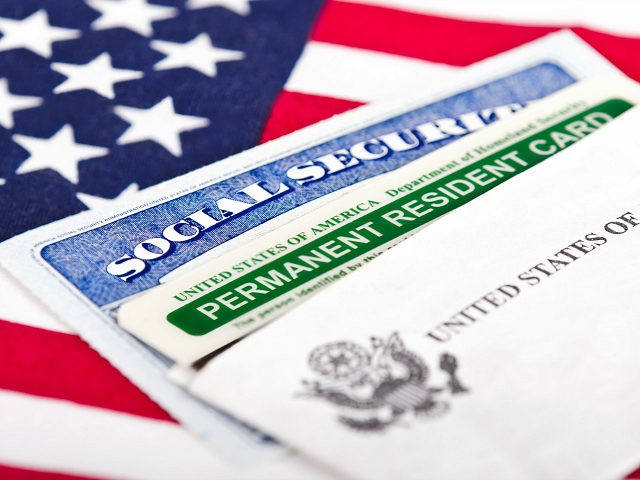The number of foreigners getting green cards and legal resident status in the United States dropped by just 7.3 percent from 2016 to 2018, according to data released January 6 by the Department of Homeland Security.
The small but useful decline from 1.18 million in 2016 down to 1.1 million in 2018 means that for every 14 green cards handed out in 2016, just 13 green cards were handed out in 2018. This drop reduces the flood of new workers to employers, and it nudges down housing pressure and school overcrowding.
But the inflow is still huge: It amounts to two legal immigrants for every seven American births. In 2019, mothers gave birth to 3,79 million Americans.
The improvement is denounced by business investors who want the federal government to import many more workers, consumers, and real estate customers. The migrant inflow helps to pump up their sales, profits, and stock values.
The percentage drop in green cards from 2016 to 2018 is actually 11.5 percent once the simultaneous decline in new refugees is counted, complained Stuart Anderson, a pro-migration advocate who writes for Forbes.com:
The latest statistics show efforts by administration officials to reduce legal immigration have, from their perspective, started to bear fruit. Favorable court rulings and another four years in power would mean even lower levels of legal immigration to the United States and fewer U.S. citizens allowed to have their spouses, parents and children come live with them in America.
President Donald Trump’s policies did sharply reduce the inflow of migrants from Muslim cultures, Anderson said:
The presidential proclamation issuing the travel ban against five majority-Muslim nations – Iran, Libya, Somalia, Syria and Yemen, with certain restrictions added for Venezuela and North Korea – reduced immigration from those five countries by 18,595 (or 64.7%) between FY 2016 and FY 2018 (excluding refugees and asylees approved in earlier years).
The number of legal immigrants (excluding refugees and asylees) admitted from Yemen declined from 12,906 in FY 2016 to 1,661 in FY 2018, while legal immigration from Iran dropped from 10,187 in FY 2016 to 5,675 in FY 2018.
However, Trump’s policies have not reduced significantly the inflow of foreign college graduate workers into the United States via the visa worker programs.
These include the H-1B, L-1, Optional Practical Training programs, and green card sponsorship programs. Overall, roughly 1.5 million foreign college graduate workers hold jobs in the United States, including at least 300,000 who are working while waiting for green cards. The imported workers are intended to suppress salaries earned by American professionals.
Trump’s statements about foreign workers show him zig-zagging between his voters and his donors.
“We have to allow smart people to stay in our country — if you graduate number one in your class at Harvard, [if] you graduate from the Wharton School of Finance,” Trump told radio host Laura Ingraham on January 10. “If we tell smart people to get the hell out, that’s not America first.”
Ingraham reminded Trump of the Disney H-1B scandal in 2016, where hundreds of Americans were replaced by H-1B workers. “You ran on people training their foreign replacements, that you ran against that. It’s humiliating for an American worker who works for a company for 30 years … to train your replacement,” Ingraham said.
“No, no, that’s different, I would never do that,” said Trump.
“Why shouldn’t we have American graduates of colleges and universities taking those jobs? Ingraham said.
The DHS data does not show the number of foreign workers who are working in the United States. It only provides the number of foreign workers’ “admissions.” This admission number overcounts the actual number of foreign workers because many leave and return multiple times each year. The agencies refuse to provide any data on the resident number of foreign H-1B, L-1, J-1, or E-3 workers.
But officials are recalculating the OPT numbers to show a reduction from 2017 to 2018. Data provided to Breitbart News by the DHS shows universities provided 215,000 OPT work permits in 2018, supposedly down from 280,000 work permits in 2017. This revised 2018 total consisted of 145,586 migrants with one year OPT work permits and 69,650 migrants with three year OPT-STEM work permits.
The inflow of OPT workers would likely skyrocket if Sen. Mike Lee, R-Utah, passes his S.386 bill. The legislation would allow an unlimited number of foreign temporary migrants to get permanently renewable work permits once they can persuade — or pay — their U.S. employer to nominate them for a green card. This “Early Adjustment” rule would allow a huge number of foreign college graduates to permanently live and work in the United States, even without receiving green cards.
Other data shows that more than at least 1.7 million foreigners got “Employment Authorization Documents” in 2019 to work in the United States, including a few hundred thousand migrants from Central America. These migrants tend to reduce wages for blue collar Americans.
Also, both Democrats and Republicans in Congress are blocking efforts to deport more of the resident population of illegal immigrants. That population includes at least 11 million consumers and eight million workers.
The award of green cards is a different process from the subsequent award of citizenship via naturalization. Naturalization rates have remained stable, at 753,060 naturalizations in 2016 and 761,901 naturalizations in 2018, according to the DHS data.


COMMENTS
Please let us know if you're having issues with commenting.